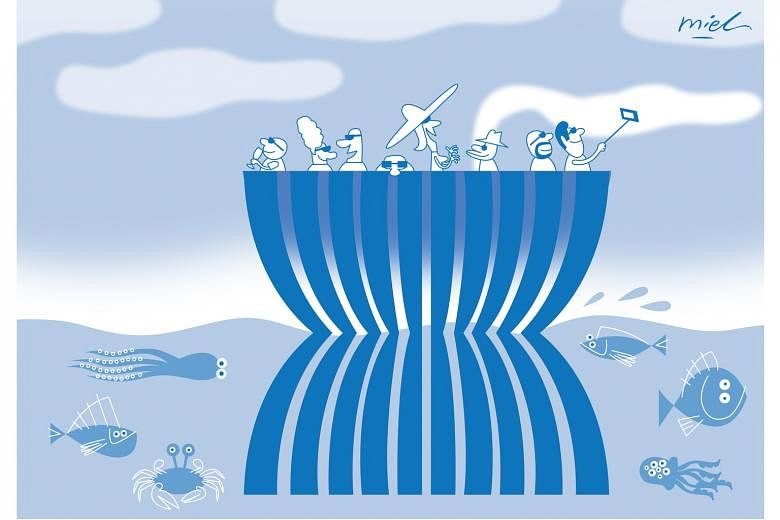A 30-year-old dream to turn South-east Asia into a cruise haven on the scale of the Caribbean is enjoying a revival. The region's thousands of islands, scattered between the Indian and Pacific oceans, offer world-class attractions ranging from Cambodia's ancient Angkor Wat temple complex to Indonesia's Komodo island, home to the Komodo dragon - the world's biggest lizards.
But its port infrastructure lags behind and that is one reason the cruise industry has not taken off as hoped. That is a lost opportunity. As it is, the cruise industry in South-east Asia contributed US$1.6 billion (S$2.3 billion) in direct expenditure and created some 34,000 jobs in 2014. The industry has grown considerably since then. By 2035, the number of cruise passengers to South-east Asia could increase tenfold to 4.5 million, regional grouping Asean has projected.
Then there is the even larger pool of visitors to South-east Asia who might be persuaded to join a cruise if what was on offer was attractive enough. Visitor arrivals to the region are rising fast - almost doubling from 62 million in 2007 to 109 million in 2015. Another source of growth for the cruise sector is the region's middle class, who are growing in number and rising in affluence.
No surprise then that Asean governments have launched a fresh attempt to turn the tide in the region's favour when it comes to cruising the high seas.
During the Asean Tourism Forum in January, Asean ministers agreed to develop a joint declaration on cruise tourism, with Singapore as the lead coordinator, to work on areas such as infrastructure development, improved onshore activities and training of staff. Their tagline for Cruise South-east Asia is "Feel the warmth" which celebrates the region's climate and the quality of its hospitality.
At the forum, Prime Minister Lee Hsien Loong said the region's archipelagos, plus the year-round tropical weather and calm waters, meant it was well placed to promote cruise tourism. "We have the archipelagos in Asean to rival the Aegean, the Caribbean or the South Pacific," he said.

SIZE MATTERS
In all, South-east Asia has more than 25,000 islands, compared with the Caribbean's 7,000 or so and some 6,000 in Greece.
Mr Robert Guy, managing director of cruise specialist Destination Asia, said the region's year-round warm weather makes it the "perfect choice" for global cruise lines looking for alternative cruising locations during the winter months in North Asia, Northern Europe and Alaska.
Royal Caribbean Cruises' managing director for Singapore and South-east Asia Sean Treacy noted that there are as many as 30 cruise ports throughout South-east Asia, which offer "impressive cultural, historical and scenic attractions, plus great shopping and gastronomic experiences". Popular spots include Langkawi, Phuket, Halong Bay and Bali.
One seasoned cruise traveller, Madam S.N. Yeo, 62, said that Asean countries can do more to market their lesser-known attractions to attract travellers like her. Madam Yeo, a retired executive assistant, has been on fly-cruises to the Mediterranean, Caribbean, Alaska and South America as well as a regional cruise to Penang, Langkawi and Phuket. But she is keen to take more regional cruises from Singapore.
"The plus point is that I don't need to fly (to board the cruise)," she said. What has held Asean up is infrastructure, which cruise industry players describe as the No. 1 problem.
Mr Treacy noted that, in response to demand, newer cruise ships deployed to the region are getting larger - from a 2,000-guest capacity 10 years ago to as large as 4,900 today, more than doubling in size.
In South-east Asia, however, cruise terminals are not expanding fast enough to cater to the bigger ships calling at the ports.
"The port infrastructure in many parts of South-east Asia needs to be upgraded urgently to accommodate these larger ships and passenger loads," said Mr Treacy.
This could be in terms of dredging, berth extension or bollard upgrade to meet the cruise lines' operational requirements, and building a proper cruise terminal "for a more welcoming tourist experience, compared to a container or cargo terminal", he added.
Royal Caribbean's newest and largest ship, Ovation of the Seas, can carry 4,905 guests, while Genting Hong Kong's Genting Dreams, launched last November, can take 3,400 passengers. Princess Cruises' newest ship, Majestic Princess, has a capacity for 3,560 guests.
The lack of proper port infrastructure limits where big ships can sail to, which means that currently, Malacca, Bali and Ho Chi Minh City are left out of some itineraries.
And sometimes, passengers are subjected to unnecessary inconvenience.
Most of the ports along the Strait of Malacca are "very stretched" during the cruise season, which is typically from October to May, said Mr Guy.
When more vessels call at a port than its cruise terminal can handle, cruise ships have no choice but to anchor offshore. Their passengers then have to board tender boats to get to land, a process that creates bottlenecks and dissatisfaction, he added.
The lack of infrastructure development is due to several reasons. Asean countries either lack funds or prioritise spending on other areas. And the fact that international cruise lines call only seasonally and not year-round in Asean ports makes it more difficult to justify spending on port infrastructure.
That is one key difference between this region and the Caribbean, where there are weekly sailings and virtually year-round calls at key islands, noted Mr Guy. That is because the region is near Miami and Fort Lauderdale, two launch points for high-capacity, high-frequency cruise ships.
Because of such frequent sailings, Carribean countries - many of which are also poor - have found it worth their while to develop the required infrastructure.
Mr Guy added that "many Caribbean island nations have almost no other source of revenue than tourists spending while ashore from cruise ships. As a result, this is essential infrastructure for them to build".
Besides cruise terminals, destinations have to be ready for the sudden influx of guests that cruise ships bring, said Princess Cruises' South-east Asia director Farriek Tawfik.
That means having attractions near their ports and ensuring there are enough tour guides and tour buses for shore excursions.
But building such infrastructure requires money that countries may not be willing to part with.
"Some of the ports have thought about this, some have developed designs but almost every single one has a funding problem as port facilities are very expensive and the recovery is very long-term," said Mr Guy.
"Oftentimes, fund allocations go to roads, schools, hospitals, et cetera, which have a direct perceived benefit to the local populace."
The Cruise Lines International Association Asia - a cruise industry trade association - said cruise lines are open to collaborating with destinations through co-investments in port facilities and joint promotions.
"The ball is in the destination's court to reciprocate," said the association's secretary-general David Goh. It is a resource issue, he added, as governments have to juggle their budget priorities.
WAVE OF CHANGE?
The dream to turn South-east Asia into a leading cruise destination has been discussed since 1991 but got lost at sea for much of the last quarter century. Sceptics will question if this latest effort will indeed gather steam or sink without a trace. But this time, Asean looks like it has a better shot at overcoming its problems.
Indonesia has said that it will be reviewing its immigration procedures and prioritise infrastructure development to allow the berthing of larger cruise ships. The Philippines last year rolled out a comprehensive plan for cruise development which involves building new cruise facilities in its capital, Manila.
Meanwhile, the Singapore Tourism Board is working with various countries to "set out principles that will spur port as well as destination-related developments", said its assistant chief executive for policy and planning Yap Chin Siang.
If Asean puts its money where its mouth is, it could be smoother sailing for the cruise industry in the years ahead.


